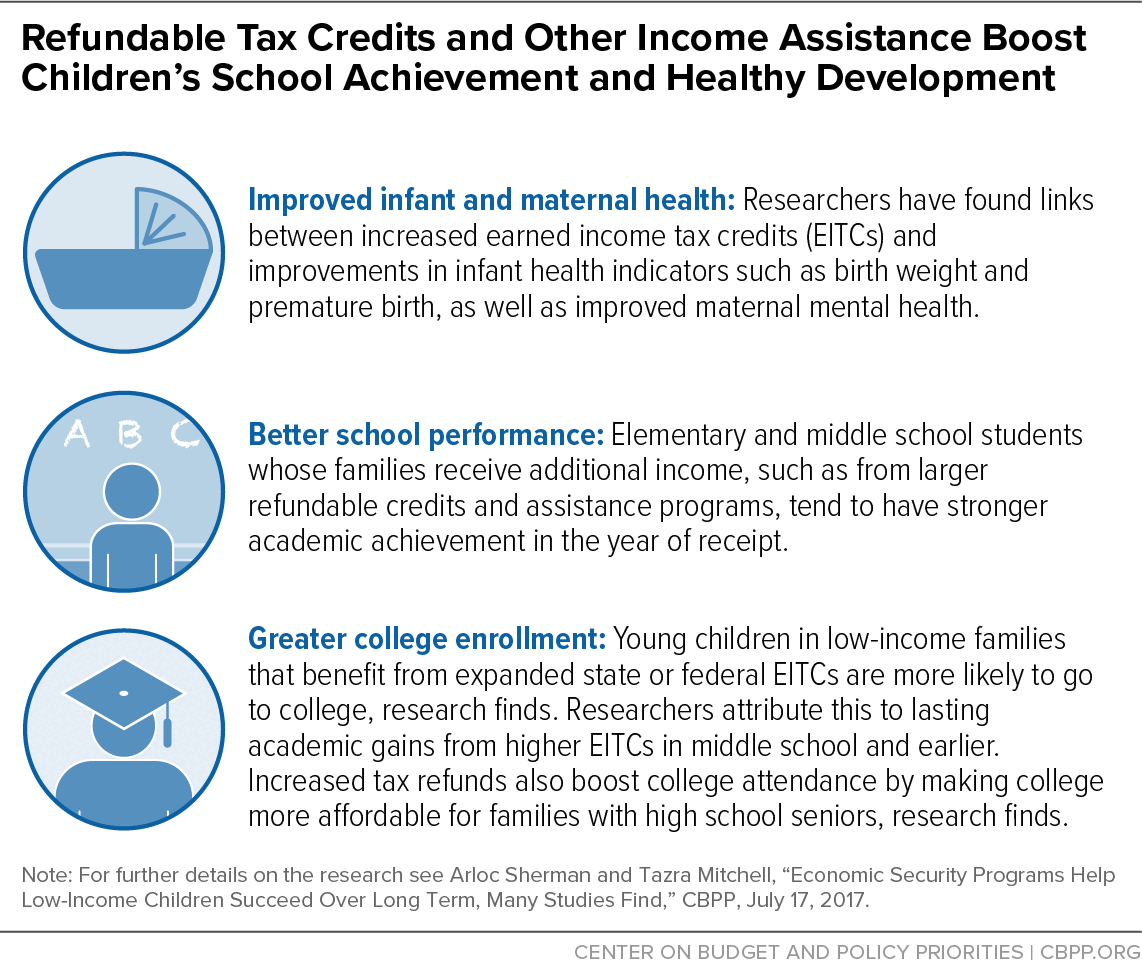Income Support Associated With Improved Health Outcomes for Children, Many Studies Show
Refundable Tax Credits Among Programs That Boost Income
End Notes
[1] See, for example, Paula A. Braveman et al., “Socioeconomic Disparities in Health in the United States: What the Patterns Tell Us,” American Journal of Public Health, April 2010, 100 (S1): S186–S196, http://www.ncbi.nlm.nih.gov/pmc/articles/PMC2837459/.
[2] Greg J. Duncan and Katherine Magnuson, “The Long Reach of Early Childhood Poverty,” Pathways, Winter 2011, http://inequality.stanford.edu/sites/default/files/PathwaysWinter11_Duncan.pdf; Caroline Ratcliffe, “Child Poverty and Adult Success,” Urban Institute, September 9, 2015, http://www.urban.org/sites/default/files/alfresco/publication-pdfs/2000369-Child-Poverty-and-Adult-Success.pdf.
[3] Data are only available by income for Black, Latinx, and white people. However, American Indians and Alaska Natives have lower incomes and are more likely to have incomes below the poverty level than white people. See: “Profile, American Indian/Alaska Native,” U.S. Department of Health and Human Services Office of Minority Health, last modified May 21, 2021, https://minorityhealth.hhs.gov/omh/browse.aspx?lvl=3&lvlid=62.
[4] National Center for Health Statistics, “Health, United States, 2017: With Special Feature on Mortality,” 2018, Table 45, Respondent-assessed fair-poor health status, by selected characteristics: United States, selected years 1991–2016, https://www.cdc.gov/nchs/data/hus/2017/045.pdf.
[5] National Academies of Sciences, Engineering, and Medicine, A Roadmap to Reducing Child Poverty, National Academies Press, 2019, https://www.nap.edu/read/25246.
[6] David Simon, Mark McInerney, and Sarah Goodell, “The Earned Income Tax Credit, Poverty, and Health,” Health Affairs, October 4, 2018, https://bit.ly/3phiM5T; Arloc Sherman and Tazra Mitchell, “Economic Security Programs Help Low-Income Children Succeed Over Long Term, Many Studies Find,” Center on Budget and Policy Priorities, July 17, 2017, https://bit.ly/2WIWE8c.
[7] The authors controlled for changes to the Aid to Families with Dependent Children (AFDC) program and the adoption of Temporary Assistance for Needy Families (which replaced AFDC), changes in Medicaid or Children’s Health Insurance Program income-eligibility thresholds, the unemployment rate, and the unique impact that belonging to a particular demographic or socio-economic group, living in a particular state, having a particular number of children, and idiosyncrasies of a particular year might have on the incidence of low birth weights for each group of women in their analysis.
[8] Hilary W. Hoynes, Douglas L. Miller, and David Simon, “The EITC: Linking Income to Real Health Outcomes,” University of California Davis Center for Poverty Research, Policy Brief, 2013, http://poverty.ucdavis.edu/research-paper/policy-brief-linking-eitc-income-real-health-outcomes.
[9] Kelli A. Komro et al., “Effects of State-Level Earned Income Tax Credit Laws on Birth Outcomes by Race and Ethnicity,” Health Equity, March 13, 2019, https://www.liebertpub.com/doi/full/10.1089/heq.2018.0061.
[10] Sara Markowitz et al., “Effects of state-level Earned Income Tax Credit laws in the U.S. on maternal health behaviors and infant health outcomes,” Social Science & Medicine, 194, October 16, 2017, p. 72. https://www.ncbi.nlm.nih.gov/pmc/articles/PMC5696026/
[11] Kate W. Strully, David H. Rehkopf, and Ziming Xuan, “Effects of Prenatal Poverty on Infant Health: State Earned Income Tax Credits and Birth Weight,” American Sociological Review, August 2010, pp. 1-29, http://www.irp.wisc.edu/newsevents/workshops/2011/participants/papers/15-Strully.pdf; Hoynes, Miller, and Simon, op. cit.; and William N. Evans and Craig L. Garthwaite, “Giving Mom a Break: The Impact of Higher EITC Payments on Maternal Health,” American Economic Journal: Economic Policy, Vol. 6, No. 2, 2014, pp. 258-290. Health indicators include self-reported “excellent” and “very good” health days per month, number of bad mental health days in the past month, and biomarkers of elevated stress levels from physical, blood, and urine tests.
[12] Otto Lenhart, “The effects of income on health: new evidence from the Earned Income Tax Credit,” Review of Economics of the Household, Vol. 17, 2019, pp. 377–410, https://link.springer.com/content/pdf/10.1007%2Fs11150-018-9429-x.pdf; and David H. Rehkopf, Kate W. Strully, and William H. Dow, “The short-term impacts of earned income tax credit disbursement on health,” International Journal of Epidemiology, Vol. 43, No. 6, December 2014, pp. 1884-94, https://www.ncbi.nlm.nih.gov/pmc/articles/PMC4342690/.
[13] Hilary W. Hoynes, Diane Whitmore Schanzenbach, and Douglas Almond, “Long-Run Impacts of Childhood Access to the Safety Net,” American Economic Review, Vol. 106, 2016, pp. 903, 930; Douglas Almond, Hilary W. Hoynes, and Diane Whitmore Schanzenbach, “Inside the War on Poverty: The Impact of Food Stamps on Birth Outcomes,” Review of Economics and Statistics, Vol. 93, No. 2, May 2011, pp. 387-403, https://www.irp.wisc.edu/publications/dps/pdfs/dp135908.pdf. For a summary of additional research in this area, see also Sherman and Mitchell, op. cit.
[14] Chloe N. East, “The Effect of Food Stamps on Children’s Health: Evidence from Immigrants’ Changing Eligibility,” University of Colorado Denver, September 2, 2016, https://bit.ly/3pbNzB2.
[15] Almond, Hoynes, and Schanzenbach, op. cit.
[16] Lenhart, op. cit.
[17] Leslie McGranahan and Diane W. Schanzenbach, “The Earned Income Tax Credit and Food Consumption Patterns,” Federal Reserve Bank of Chicago, Working Paper No. 2013-14, https://www.econstor.eu/bitstream/10419/96640/1/773868097.pdf.
[18] Rehkopf, Strully, and Dow, op. cit.
[19] Virginia Commonwealth University Center on Society and Health, “Why Education Matters to Health: Exploring the Causes,” February 13, 2015, https://societyhealth.vcu.edu/work/the-projects/why-education-matters-to-health-exploring-the-causes.html.
[20] Gordon Dahl and Lance Lochner, “The Impact of Family Income on Child Achievement: Evidence from the Earned Income Tax Credit,” American Economic Review, Vol. 102, No. 5, August 2012, pp. 1927-1956, http://www.aeaweb.org/articles.php?doi=10.1257/aer.102.5.1927. In 2017, Dahl and Lochner revised their estimates for the effect on combined math and reading scores to 4 percent of a standard deviation from 6 percent, but concluded that the revision did not change the study’s qualitative conclusions. When adjusting those effects into 2013 dollars, their findings suggest that the EITC raised test scores by 3 percent of a standard deviation for each additional $1,000 of income. See Gordon Dahl and Lance Lochner, “Correction and Addendum to ‘The Impact of Family Income on Child Achievement: Evidence from the Earned Income Tax Credit,’” March 1, 2016, http://econweb.ucsd.edu/~gdahl/papers/children-and-EITC-correction-addendum.pdf; and Gordon Dahl and Lance Lochner, “The Impact of Family Income on Child Achievement: Evidence from the Earned Income Tax Credit: Reply,” American Economic Review, Vol. 107, No. 2, 2017, pp. 629-631.
[21] Michelle Maxfield, “The Effects of the Earned Income Tax Credit on Child Achievement and Long-Term Educational Attainment,” Michigan State University Job Market Paper, November 14, 2013, http://ippsr.msu.edu/research/effects-earned-income-tax-credit-child-achievement-and-long-term-educational-attainment.
[22] Raj Chetty, John N. Friedman, and Jonah Rockoff, “New Evidence on the Long-Term Impacts of Tax Credits,” Statistics of Income Paper Series, November 2011, http://www.irs.gov/pub/irs-soi/11rpchettyfriedmanrockoff.pdf.
[23] Maxfield, op. cit.; Katherine Michelmore, “The Effect of Income on Educational Attainment: Evidence from State Earned Income Tax Credit Expansions,” November 2013, https://ssrn.com/abstract=2356444; Dahl and Lochner, 2012, op. cit.
[24] See Hoynes, Whitmore Schanzenbach, and Almond, op. cit.; Greg Duncan, Pamela Morris, and Chris Rodrigues, “Does Money Really Matter? Estimating Impacts of Family Income on Young Children’s Achievement with Data from Random-Assignment Experiments,” Developmental Psychology, Vol. 47, No. 5, 2011; Randall K. Q. Akee et al., “Parents’ Incomes and Children’s Outcomes: A Quasi-Experiment Using Transfer Payments from Casino Profits,” American Economic Journal: Applied Economics, Vol. 2, No. 1, 2010, https://bit.ly/3mMl5fI.
[25] Maxfield, op. cit.; Chetty, Friedman, and Rockoff, op. cit.
[26] Dayanand S. Manoli and Nicholas Turner, “Cash-on-hand and College Enrollment: Evidence From Population Tax Data and Policy Nonlinearities,” National Bureau of Economic Research Working Paper No. 19836, revised April 2016, http://www.nber.org/papers/w19836. The researchers studied effects on high school seniors whose family incomes were near the first kink point of the EITC benefit schedule.
[27] Austin Nichols and Jesse Rothstein, “The Earned Income Tax Credit (EITC),” National Bureau of Economic Research Working Paper No. 21211, May 2015, p. 5, http://www.nber.org/papers/w21211.pdf.
[28] Pamela A. Morris, Lisa A. Gennetian, and Greg J. Duncan, “Effects of Welfare and Employment Policies on Young Children: New Findings on Policy Experiments Conducted in the Early 1990s,” Social Policy Report, Vol. 19, No. 2, 2005, http://www.srcd.org/sites/default/files/documents/spr19-2.pdf.
[29] Pamela A. Morris, “The Effects of Welfare Reform Policies on Children,” Social Policy Report, Vol. 16, No. 1, 2002, http://srcd.org/sites/default/files/documents/spr16-1.pdf.
[30] April S. Masarik and Rand D. Conger, “Stress and Child Development: A Review of the Family Stress Model,” Current Opinion in Psychology, Vol. 13, pp. 85-90, https://scholarworks.boisestate.edu/cgi/viewcontent.cgi?article=1238&context=psych_facpubs; Rand D. Conger et al., “Economic Stress, Coercive Family Process, and Developmental Problems of Adolescents,” Child Development, Vol. 65, No. 2, April 1994, https://www.jstor.org/stable/1131401; Rand D. Conger et al., “Economic pressure in African American families: a replication and extension of the family stress model,” Developmental Psychology, Vol. 38, No. 2, March 2002, https://pubmed.ncbi.nlm.nih.gov/11881755/.
[31] National Scientific Council on the Developing Child, “Connecting the Brain to the Rest of the Body: Early Childhood Development and Lifelong Health Are Deeply Intertwined,” Working Paper No. 15, June 2020, https://developingchild.harvard.edu/resources/connecting-the-brain-to-the-rest-of-the-body-early-childhood-development-and-lifelong-health-are-deeply-intertwined/.
[32] Anna Aizer, Laura Stroud, and Stephen Buka, “Maternal Stress and Child Outcomes: Evidence from Siblings,” National Bureau of Economic Research Working Paper No. 18422, September 2012, https://www.nber.org/papers/w18422.
[33] Greg Duncan, Katherine Magnuson, and Elizabeth Votruba-Drzal, “Boosting Family Income to Promote Child Development,” Future of Children, Vol. 24, No. 1, Spring 2014, p. 109, https://www.fcd-us.org/assets/2014/07/24_01_05.pdf.
[34] Evans and Garthwaite, op. cit.





